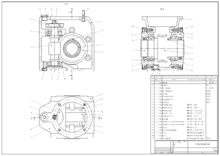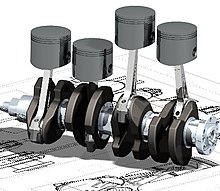Computer-aided design (


Its use in designing electronic systems is known as electronic design automation (EDA). In mechanical design it is known as mechanical design automation (MDA), which includes the process of creating a technical drawing with the use of computer software.[3]
The design of geometric models for object shapes, in particular, is occasionally called computer-aided geometric design (CAGD).[7]
Overview
Computer-aided design is one of the many tools used by engineers and designers and is used in many ways depending on the profession of the user and the type of software in question.
- Computer-aided engineering (CAE) and finite element analysis (FEA, FEM)
- Computer-aided manufacturing (CAM) including instructions to computer numerical control (CNC) machines
- Photorealistic rendering and motion simulation
- Document management and revision control using product data management (PDM)
Types
There are several different types of
2D CAD
There are many producers of the lower-end 2D sketching systems, including a number of free and open-source programs. These provide an approach to the drawing process where scale and placement on the drawing sheet can easily be adjusted in the final draft as required, unlike in hand drafting.
3D CAD
3D wireframe is an extension of 2D drafting into a three-dimensional space. Each line has to be manually inserted into the drawing. The final product has no mass properties associated with it and cannot have features directly added to it, such as holes. The operator approaches these in a similar fashion to the 2D systems, although many 3D systems allow using the wireframe model to make the final engineering drawing views.
3D "dumb" solids are created in a way analogous to manipulations of real-world objects. Basic three-dimensional geometric forms (e.g., prisms, cylinders, spheres, or rectangles) have solid volumes added or subtracted from them as if assembling or cutting real-world objects. Two-dimensional projected views can easily be generated from the models. Basic 3D solids do not usually include tools to easily allow the motion of the components, set their limits to their motion, or identify interference between components.
There are several types of 3D solid modeling
- Parametric modeling allows the operator to use what is referred to as "design intent". The objects and features are created modifiable. Any future modifications can be made by changing on how the original part was created. If a feature was intended to be located from the center of the part, the operator should locate it from the center of the model. The feature could be located using any geometric object already available in the part, but this random placement would defeat the design intent. If the operator designs the part as it functions, the parametric modeler is able to make changes to the part while maintaining geometric and functional relationships.
- Direct or explicit modeling provide the ability to edit geometry without a history tree. With direct modeling, once a sketch is used to create geometry it is incorporated into the new geometry, and the designer only has to modify the geometry afterward without needing the original sketch. As with parametric modeling, direct modeling has the ability to include the relationships between selected geometry (e.g., tangency, concentricity).
- Assembly modelling is a process which incorporates results of the previous single-part modelling into a final product containing several parts. Assemblies can be hierarchical, depending on the specific
CAD software vendor, and highly complex models can be achieved (e.g. in building engineering by using computer-aided architectural design software)[10]: 539
Freeform CAD
Top-end
Technology
Originally software for
Unexpected capabilities of these associative relationships have led to a new form of prototyping called digital prototyping. In contrast to physical prototypes, which entail manufacturing time in the design. That said,
Today,
Currently, no special hardware is required for most
The human-machine interface is generally via a computer mouse but can also be via a pen and digitizing graphics tablet. Manipulation of the view of the model on the screen is also sometimes done with the use of a Spacemouse/SpaceBall. Some systems also support stereoscopic glasses for viewing the 3D model. Technologies that in the past were limited to larger installations or specialist applications have become available to a wide group of users. These include the CAVE or HMDs and interactive devices like motion-sensing technology
Software
Starting with the IBM Drafting System in the mid-1960s, computer-aided design systems began to provide more capabilitties than just an ability to reproduce manual drafting with electronic drafting, and the cost-benefit for companies to switch to
License management software
In the 2000s, some
List of software packages
Based on market statistics, commercial software from Autodesk, Dassault Systems, Siemens PLM Software, and PTC dominate the
Commercial software
- AC3D
- Alibre Design
- ArchiCAD (Graphisoft)
- AutoCAD (Autodesk)
- AxSTREAM
- BricsCAD
- CATIA (Dassault Systèmes)
- Cobalt
- CorelCAD
- Fusion 360 (Autodesk)
- IntelliCAD
- Inventor (Autodesk)
- IRONCAD
- KeyCreator (Kubotek)
- Landscape Express
- MEDUSA
- MicroStation (Bentley Systems)
- Modelur (AgiliCity)
- Onshape (PTC)
- NX (Siemens Digital Industries Software)
- PTC Creo (successor to Pro/ENGINEER) (PTC)
- PunchCAD
- Remo 3D
- Revit (Autodesk)
- Rhinoceros 3D
- SketchUp
- Solid Edge (Siemens Digital Industries Software)
- SOLIDWORKS (Dassault Systèmes)
- SpaceClaim
- T-FLEX
CAD - TranslateCAD
- TurboCAD
- Vectorworks (Nemetschek)
Open-source software
Freeware
- BricsCAD Shape
- TiffinCAD
- Tinkercad (successor to Autodesk 123D)
CAD kernels
- ACIS by (Spatial Corp owned by Dassault Systèmes)
- C3D Toolkit by C3D Labs
- Open CASCADE Open Source
- Parasolid by (Siemens Digital Industries Software)
- ShapeManager by (Autodesk)
See also
- 3D computer graphics – Graphics that use a three-dimensional representation of geometric data
- 3D printing – Additive process used to make a three-dimensional object
- Additive Manufacturing File Format – Open standard for describing objects for additive manufacturing processes such as 3D printing
- Algorithmic art – Art genre
CAD standards – type of technical standardCAD library - cloud based repository of 3D models or parts- Coarse space (numerical analysis) – reduced representation of a numerical problem
- Comparison of 3D computer graphics software
- Comparison of
CAD , CAM, and CAE file viewers - Comparison of computer-aided design software
- Comparison of EDA software (electronic design automation)
- Computer-aided industrial design – Subset of computer-aided design
- Digital architecture – Architecture using digital technology
- Digital twin – Digital replica of a living or non-living physical entity
- Electronic design automation – Software for designing electronic systems
- Engineering optimization – Techniques for optimization
- Finite element method – Numerical method for solving physical or engineering problems
- ISO 128 – International standard about the graphical representation of objects on technical drawings
- ISO 10303 – ISO standard (STEP)
- List of computer-aided engineering software
- Model-based definition – Annotating computer-aided design models
- Molecular design software –
CAD software for molecular-level engineering, modelling, and analysis - Open-source hardware – Hardware from the open-design movement
- Rapid prototyping – Group of techniques to quickly construct physical objects
- Responsive computer-aided design – Approach to computer-aided design
- Space mapping – Design optimization methodology
- Surrogate model – Engineering model
- System integration – Bringing together component sub-systems into one system
- Virtual prototyping – Computer-simulated prototype development
- Virtual reality – Computer-simulated experience
References
- ^ a b Narayan, K. Lalit (2008). Computer Aided Design and Manufacturing. New Delhi: Prentice Hall of India. ISBN 978-8120333420.
- ^ Duggal, Vijay (2000). Cadd Primer: A General Guide to Computer Aided Design and Drafting-Cadd,
CAD . Mailmax Pub. ISBN 978-0962916595. - ^ Madsen, David A. (2012). Engineering Drawing & Design. Clifton Park, New York: Delmar. p. 10. ISBN 978-1111309572.
- ^ Farin, Gerald; Hoschek, Josef; Kim, Myung-Soo (2002). Handbook of computer aided geometric design [electronic resource]. Elsevier. ISBN 978-0-444-51104-1.
- ^ a b c d e f Schoonmaker, Stephen J. (2003). The
CAD guidebook : a basic manual for understanding and improving computer-aided design. New York: Marcel Dekker. ISBN 0-8247-0871-7. OCLC 50868192. - ^ Pottmann, H.; Brell-Cokcan, S. and Wallner, J. (2007) "Discrete surfaces for architectural design" Archived 2009-08-12 at the Wayback Machine, pp. 213–234 in Curve and Surface Design, Patrick Chenin, Tom Lyche and Larry L. Schumaker (eds.), Nashboro Press, ISBN 978-0-9728482-7-5.
- ^ Farin, Gerald (2002) Curves and Surfaces for CAGD: A Practical Guide, Morgan-Kaufmann, ISBN 1-55860-737-4.
- ^ "Computer-Aided Design (
CAD ) and Computer-Aided Manufacturing (CAM)". Inc.com. Retrieved 2020-04-30. - ^ "3D Feature-based, Parametric Solid Modeling". EngineersHandbook.com. Archived from the original on 2012-11-18. Retrieved 2012-03-01.
- ^ Stroud, Ian; Nagy, Hildegarde (2011). Solid modelling and
CAD systems: how to survive aCAD system. London New York: Springer. ISBN 978-0-85729-259-9. - ^ "What is a
CAD Workstation? Definition, Uses and More". Computer Tech Reviews. 2019-11-21. Retrieved 2020-04-30. - ^ Jennifer Herron (2010). "3D Model-Based Design: Setting the Definitions Straight". MCADCafe.
- ^ The Big 6 in
CAD /CAE/PLM software industry (2011), CAEWatch, September 12, 2011 - ^ van Kooten, Michel (2011-08-23). "GLOBAL SOFTWARE TOP 100 – EDITION 2011". Software Top 100.
- ^ List of mechanical
CAD softwares Archived 2020-07-28 at the Wayback Machine, BeyondMech
External links
- MIT 1982
CAD lab - Learning materials related to Computer-aided design at Wikiversity
- Learning materials related to Computer-aided Geometric Design at Wikiversity